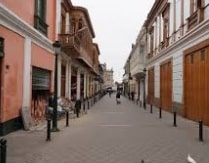The term jirón comes from the French giron , which can be translated as “lap” . The first meaning of the concept - whose plural is shreds - mentioned by the Royal Spanish Academy ( RAE ) in its dictionary refers to the torn piece of a piece of clothing .
 For example: “The dog left my dress in tatters,” “The shreds of my shirt were scattered all over the house,” “I tried to catch him but I was left with shreds of his shirt in my hand.”
For example: “The dog left my dress in tatters,” “The shreds of my shirt were scattered all over the house,” “I tried to catch him but I was left with shreds of his shirt in my hand.”
Starting from this meaning, we can establish that among the words that can function as synonyms for jirón are both tear and tatter, rag, tear, guiñapo, seven, tear or pingajo.
In a broader sense, a fragment or part of a whole is called a shred. In this framework, the notion can be used in a symbolic sense: “We are still suffering from the shreds of the crisis,” “Little by little, shreds of the truth are coming to light: in the not-so-distant future, we will know exactly what happened.” , “I left shreds of my life in this company, I think I deserve greater recognition.”
In the field of gastronomy, the term shreds that concerns us now is also used. A good example of this is that they talk about dishes such as chicken shreds in sauce. In this way, reference is made to the fact that this meat appears cut up.
In Peru , jirones are short urban roads , formed by sectors between corners or by some streets . They are generally pedestrian sections. The Jirón de la Unión , to cite one case, is located in the historic center of the city of Lima . The Áncash jirón , the Amazonas jirón , the Junín jirón and the Gamarra jirón are other Peruvian jirónes.
In the field of heraldry , shreds are triangular figures that are based on an edge of the shield and extend to its central sector. Each shred has a dimension that is equivalent to one eighth of the total surface of the shield: this means that with the shreds it is possible to make eight divisions in a shield.
There are different theories about the meaning of the shreds in the aforementioned field of heraldry. Thus, there are some that indicate that they express that a family had royal favor, given the successes achieved by the knights. However, there are others who choose to establish that they highlighted the handkerchief that the ladies gave to the gentlemen before they participated in a tournament. It was a way to wish them luck and to show that they had their favor.
Likewise, it must be established that shreds are very common to find in heraldic shields of French families, but they hardly appear in those of families of Spanish origin.
In addition to all the above, it must be added that the word in question is very common to find in songs and poems. A good example of this is the song “Apprentice” that Malú performs and which goes like this: “I never thought I would see you mending my wounds with shreds of your skin.”
In the same way, another example is rhyme XXIV by Gustavo Adolfo Bécquer, which has the following verses: “Two shreds of steam that rise from the lake, and when they come together there in the sky they form a white cloud.”
